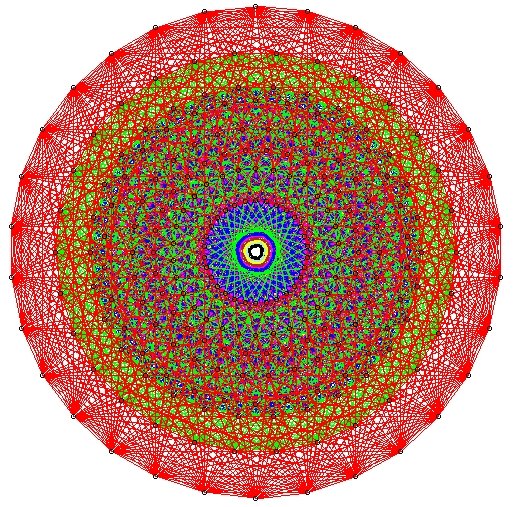|
|
|
The tables gives
|H1(Γ,G)| for every real form of a simple connected complex
group, except for some intermediate covers in type A.
Also the component groups of the adjoint groups are given.
Here is some detail
about the mathematics, the
realex code used to produce the
tables,
and the output of the script
(H1(Γ,G) for all simple, simply connected groups up to
rank 8).
This page is under construction, October 2013. Please send comments and
corrections
to jda@math.umd.edu.
| Simply Connected Classical groups |
| Group | |H1(Γ,G)| |
| SL(n,R), GL(n,R), Sp(2n,R) | 1 |
| SL(n,H), Spin*(2n) | 2 |
| SU(p,q) |
⌊p/2⌋
+
⌊q/2⌋+1
|
| Sp(p,q) | p+q+1 |
| Spin(p,q) |
⌊(p+q)/4⌋+δ(p,q) |
In the last row δ(p,q) depends on p,q mod(4), according to the
following table:
| p\q | 0 | 1 | 2 | 3 |
| 0 | 3 | 2 | 2 | 2 |
| 1 | 2 | 1 | 1 | 0 |
| 2 | 2 | 1 | 1 | 0 |
| 3 | 2 | 0 | 0 | 0 |
| Simply Connected Exceptional
groups |
| inner class |
group |
K |
real rank |
name |
|H1(Γ,G)| |
| compact |
E6 |
A5A1 |
4 |
quasisplit
quaternionic |
3 |
|
E6 |
D5T |
2 |
Hermitian |
3 |
|
E6 |
E6 |
0 |
compact |
3 |
| split |
E6 |
C4 |
6 |
split |
2 |
|
E6 |
F4 |
2 |
quasicompact |
2 |
| compact |
E7 |
A7 |
7 |
split |
2 |
|
E7 |
D6A1 |
4 |
quaternionic |
4 |
|
E7 |
E6T |
3 |
Hermitian |
2 |
|
E7 |
E7 |
2 |
compact |
4 |
| compact |
E8 |
D8 |
8 |
split |
3 |
|
E8 |
A7A1 |
4 |
quaternionic |
3 |
|
E8 |
E8 |
0 |
compact |
3 |
| compact |
F4 |
C3A1 |
4 |
split |
3 |
|
F4 |
B4 |
1 |
|
3 |
|
F4 |
F4 |
0 |
compact |
3 |
| compact |
G2 |
A1A1 |
2 |
split |
2 |
|
G2 |
G2 |
0 |
compact |
2 |
| Special orthgonal groups |
| group | |H1k(Γ,G)| |
| SO(p,q) | ⌊p/2⌋+⌊q/2⌋+1 |
| SO*(2n) | 2 |
| Adjoint classical groups |
| group | |π0(G(R))| | |H1(Γ,G)| |
| PSL(n,R) |
|
|
| PSL(n,H) | 1 | 2 |
| PSU(p,q) |
| ⌊(p+q)/2⌋+1 |
| PSO(p,q) |
| 1 | pq=0 |
| 1 | p,q odd and p≠q |
| 4 | p=q even |
| 2 | otherwise |
|
| ⌊(p+q+2)/4⌋ | p,q odd |
| ⌊(p+q)/4⌋+3 | p,q even, p+q=0(4) |
| ⌊(p+q)/4⌋+2 | p,q even, p+q=2(4) |
| (p+q+1)/2 | p,q opposite parity |
|
| PSO*(2n) |
|
| n/2+3 | n even |
| (n-1)/2+2 | n odd |
|
| PSp(2n,R) | 2 | ⌊n/2⌋+2 |
| PSp(p,q) |
| ⌊(p+q)/2⌋+2 |
In types E8, F4 and G2 the adjoint
group is simply connected.
In simply connected type E6 the center has order 3, and
the adjoint and simply connected groups have the same cohomology (and
the real points are connected). The only essentially new adjoint case is
E7.
| Adjoint exceptional groups |
| group | K | real rank | name | |π0(G(R))| |
|H1(Γ,G)| |
| E7 |
A7 |
7 |
split |
2 |
4 |
| E7 |
D6A1 |
4 |
quaternionic |
1 |
4 |
| E7 |
E6T |
3 |
Hermitian |
2 |
4 |
| E7 |
E7 |
0 |
compact |
1 |
4 |
|
| |
